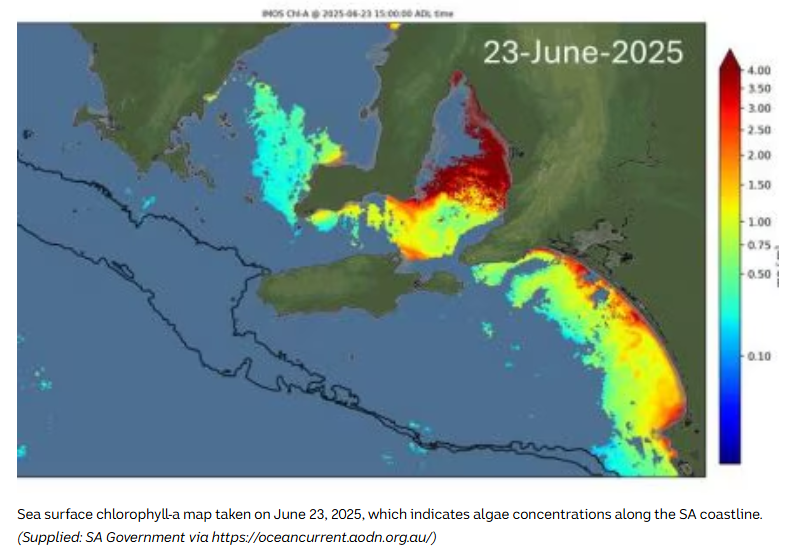SA toxic algal bloom persists under wintry conditions
Written by: Nick G. on 1 July 2025
The SA toxic algal bloom, first reported in Vanguard on April 12 (see here) has shown no signs of an anticipated dissipation as colder sea temperatures and rougher seas set it.
The algal bloom began in March at the southern tip of the Fleurieu Peninsula with masses of dead fish washed up onto popular surfing beaches, and surfers and beachgoers complaining of headaches, nausea and loss of vision.
Then the discoloured, frothy waters spread across to Kangaroo Island and parts of Yorke Peninsula. Divers at Edithburgh said all sea life was being killed. Some have described the effect as like an “underwater bush fire”.
There are various sea algae. This one was first reported in Japan in 1972 and has the scientific name Karenia mikimotoi.
Algal blooms occur when sea water temperatures rise and there is minimal disturbance of the sea by winds pushed ahead of large rain-bearing clouds, creating the perfect conditions for the growth of algae.
Algal blooms are normally dispersed when sea water temperatures return to normal, and winter brings stronger winds and stormy weather. Over the past month, both conditions have occurred. In the most recent storm surge a week ago, jetties along the SA coast were damaged, yet the toxic bloom was not.
Not only has it not disappeared, but storm winds carried the algal froth from the open beaches of the Coorong, where mass killings of cockles (pipis) had occurred, over the high sand dunes and into the Coorong, killing fish and a leaving a carpet of dead sea worms and other sea bed creatures.
In recent days, the algal bloom has travelled north to Adelaide’s suburban beaches, possibly in search of marginally warmer water.
Marine biologist Mike Bossley has spent thousands of hours roaming the beach in his lifetime, but since Tuesday has sighted species he's never seen on the shore.
"Different kinds of rays and sharks, lots of pipefish, things called ling, which is a very unusual thing. I've never seen them washed up on the beach before, and lots of species of fish that I don't even know the names of," he said.
Scientists say that if the bloom persists beyond winter, it will spread even further as warmer weather returns.
The bloom has already persisted for four months. Normally, it lasts for less than a month. The following table shows how other mikimotoi outbreaks have fared:
The SA algal bloom is longer and more intense than other mikimotoi outbreaks and is yet further proof that as carbon-induced global warming heats the planet, the scale of ecological disaster intensifies.
Capitalism, with the big fossil fuel corporations at its core, is waging a destructive war on nature in the drive for expanded accumulation of profits, of capital.
We cannot wait until we have only our proverbial chains to lose.
We are losing the war for a sustainable environment and for the prevention of the destruction of biodiversity.
With the SA government bidding to host COP31, the 2026 United Nations Conference of the Parties on Climate Change, participants will be able to choose between visiting the world’s largest renewable energy battery or the battered beaches and seas that are the evidence for urgent action, not talk-fests, to save the planet.
Print Version - new window Email article
-----
Go back
Independence from Imperialism
People's Rights & Liberties
Community and Environment
Marxism Today
International
Articles
| Why did heroes succeed after police leadership and ASIO fail at Bondi? |
| 8000 Rising Tide protesters enforce Newcastle Port shutdown |
| Modern slavery contributes to Supercars championship profits |
| People's struggle continues against SA government " love affair" with property developers and their $1 per year rent! |
| Book Review: The New Age of Sexism |
| Tuvalu: global warming forces diplomatic reappraisal |
| The uphill struggle to protect NSW’s Koalas |
| We have strength to stop Israel’s participation in cycling’s Tour Down Under |
| We welcome the call for a climate-based and more independent foreign policy. |
| Sovereign Citizens: A few inconvenient home-truths for the centre-right |
| That old divide and conquer songbook |
| Toe to toe with fossil fuel induced global warming |
| Save our Oceans rally in Adelaide |
| Resistance to Capitalist Climate Disaster |
| Large rally and march in Adelaide to celebrate first people's struggles and culture |
| Why Australia’s “deforestation” ranking ignores deforestation |
| SA toxic algal bloom persists under wintry conditions |
| Drought |
| Book Review: Terraglossia |
| Residential aged care - for people's needs or private profit? |
-----


